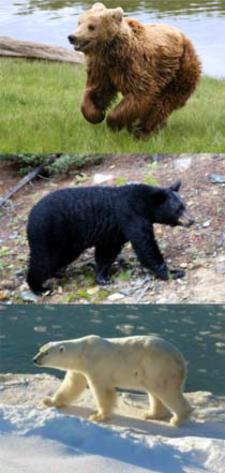 | ||||
Biological Classification & Binomial Nomenclature
What is a Species?
The species name, also called "specific epithet", is the second part of a scientific name, and refers to one species within a genus.
A species is a group of organisms that typically have similar anatomical characteristics and, in sexual reproducers, can successfully interbreed to produce fertile offspring.
In the genus Ursus, there are a number of different bear species, including Ursus arctos, the brown bear, Ursus americanus, the American black bear and Ursus maritimus, the polar bear.
What Is a Genus?
In biology, ‘genus’ is the taxonomic classification lower than ‘family’ and higher than ‘species’. In other words, genus is a more general taxonomic category than is species. For example, the generic name Ursus represents brown bears, polar bears and black bears.
Brown Bear
Ursus arctos
American
Black Bear
Ursus americanus
Polar Bear
Ursus maritimus
SPO VIRTUAL CLASSROOMS
Crash Course Biology
video on
Taxonomy
Page last updated:
3/2016
PAGE 2 < Back to Page 1
End of Article < Back to Page 1
The binomial aspect of this system means that each organism is given two names, a ‘generic name,’ which is called the genus (plural = genera) and a ‘specific name,’ the species. Together the generic and specific name of an organism are its scientific name.
Having a universal system of binomial nomenclature allows scientists to speak the same language when referring to living things, and avoids the confusion of multiple common names that may differ based on region, culture or native language.
When written, a scientific name is always either italicized, or, if hand-written, underlined. The genus is capitalized and the species name is lower case. For example, the proper format for the scientific name of humans is Homo sapiens.
The gray wolf (Canis lupus) also known as the timber wolf, is native to remote areas of North America, Eurasia, and Africa. The scientific name allows biologist from different areas of the world a common language when referring to this animal.
 | ||||
Very adorable infant male
Homo sapiens. Find out which dominant genetic traits he has (and see how cute he is growing up to be!)
See the Biological Classification Lecture Main Page for all of our FREE teaching materials on this topic!




